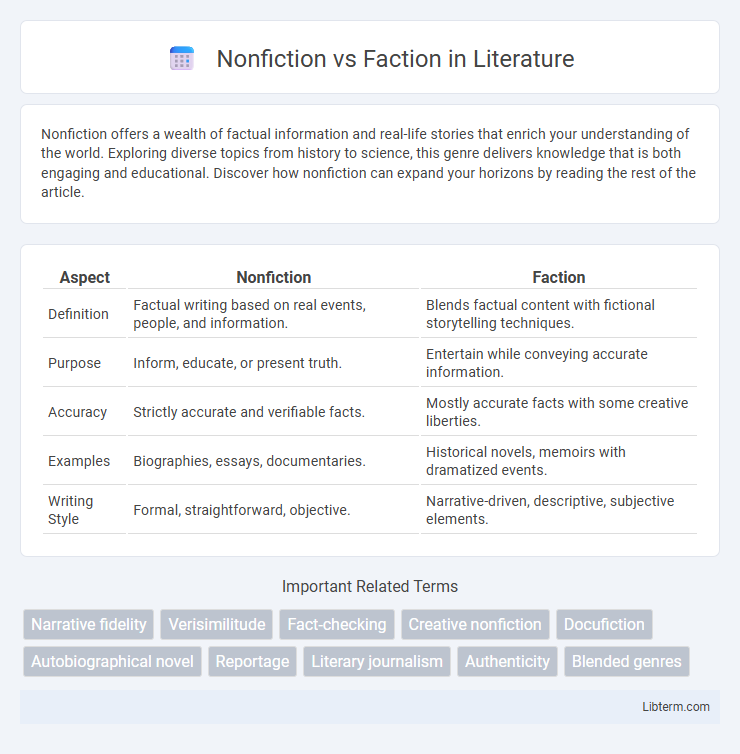Nonfiction offers a wealth of factual information and real-life stories that enrich your understanding of the world. Exploring diverse topics from history to science, this genre delivers knowledge that is both engaging and educational. Discover how nonfiction can expand your horizons by reading the rest of the article.
Table of Comparison
| Aspect | Nonfiction | Faction |
|---|---|---|
| Definition | Factual writing based on real events, people, and information. | Blends factual content with fictional storytelling techniques. |
| Purpose | Inform, educate, or present truth. | Entertain while conveying accurate information. |
| Accuracy | Strictly accurate and verifiable facts. | Mostly accurate facts with some creative liberties. |
| Examples | Biographies, essays, documentaries. | Historical novels, memoirs with dramatized events. |
| Writing Style | Formal, straightforward, objective. | Narrative-driven, descriptive, subjective elements. |
Defining Nonfiction and Faction
Nonfiction encompasses factual writing based on real events, people, or information, aiming for accuracy and truth without fictional elements. Faction blends factual content with fictional storytelling techniques, creating narratives that are rooted in reality but embellished for dramatic effect. The distinction lies in nonfiction's commitment to factual integrity versus faction's balance of truth and creative license.
Historical Origins of Both Genres
Nonfiction, rooted in ancient historiography such as Herodotus' "Histories," prioritizes factual accuracy and documentation of real events. Faction emerged in the 20th century as a hybrid genre blending factual history with narrative techniques borrowed from fiction to enhance engagement and readability. Both genres stem from a fundamental human desire to understand and interpret past realities, though nonfiction maintains strict adherence to truth, whereas faction allows creative liberties while anchored in real occurrences.
Key Characteristics of Nonfiction
Nonfiction is characterized by factual accuracy, verifiable information, and a commitment to truth, often supported by evidence such as statistics, citations, and firsthand accounts. Unlike faction, which blends factual events with fictionalized elements for narrative effect, nonfiction maintains integrity by presenting real-world subjects without fabrication. Key characteristics include objective tone, reliance on real data, and an intent to inform or educate readers on authentic topics.
Understanding the Concept of Faction
Faction blends factual information with narrative storytelling, creating a hybrid genre that presents real events through compelling literary techniques. This approach allows authors to provide historical accuracy while enhancing reader engagement by dramatizing true stories. Understanding faction involves recognizing its dual nature: it relies on authentic data yet embraces creative interpretation to convey deeper insights.
Major Differences Between Nonfiction and Faction
Nonfiction presents factual information based on verifiable evidence, while faction blends factual events with fictional elements to enhance storytelling. Nonfiction maintains accuracy and objectivity, prioritizing truth without creative embellishment, whereas faction allows creative freedom, often incorporating imagined dialogue or scenarios. The major difference lies in nonfiction's commitment to factual integrity contrasted with faction's hybrid approach to narrative and fact.
The Role of Fact and Imagination
Nonfiction relies on factual information verified through evidence, ensuring accuracy and credibility in its narrative. Faction blends real historical events with imaginative elements, creating a hybrid genre that enriches storytelling while maintaining a foundation of truth. The balance between fact and imagination in faction allows readers to engage with reality through creative interpretation and emotional depth.
Examples of Popular Nonfiction Works
Popular nonfiction works include "Sapiens: A Brief History of Humankind" by Yuval Noah Harari, a detailed exploration of human history based on scientific research. Another prominent example is "The Immortal Life of Henrietta Lacks" by Rebecca Skloot, which blends biography and scientific discovery to reveal the story behind HeLa cells. These works exemplify nonfiction's commitment to truth and factual accuracy, unlike faction, which merges factual events with fictional storytelling.
Notable Faction Books and Authors
Notable faction books blend factual events with narrative storytelling, creating an immersive reading experience that bridges nonfiction and fiction. Prominent authors like Truman Capote, with "In Cold Blood," and Norman Mailer, known for "The Executioner's Song," pioneered this genre by mixing meticulous research with literary techniques. These works stand out for their compelling reconstruction of true stories while maintaining rigorous attention to historical accuracy.
Reader Expectations and Genre Impact
Nonfiction demands factual accuracy and trustworthy sources to meet reader expectations for truth and reliability, influencing its classification within educational and journalistic genres. Faction blends factual events with fictional storytelling, creating a hybrid genre that challenges readers to discern fact from creative interpretation, often impacting historical narratives and entertainment. This genre interplay shapes how audiences engage with content, balancing informational value with narrative appeal.
Choosing Between Nonfiction and Faction
Choosing between nonfiction and faction depends on the desired balance between factual accuracy and narrative engagement. Nonfiction offers verified facts and objective analysis, ideal for readers prioritizing reliability and educational value, while faction blends factual content with storytelling techniques to create immersive, compelling narratives. Evaluating the purpose of the work and the target audience's expectations helps determine whether strict adherence to truth or creative interpretation serves better.
Nonfiction Infographic

 libterm.com
libterm.com